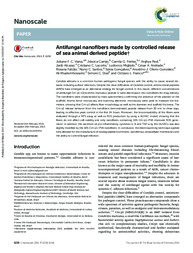Antifungal nanofibers made by controlled release of sea animal derived peptide.
Antifungal nanofibers made by controlled release of sea animal derived peptide.
Author(s): VIANA, J. F. C.; CARRIJO, J.; FREITAS, C. G.; PAUL, A.; ALCARAZ, J.; LACORTE, C. C.; MIGLIOLO, L.; ANDRADE, C. A.; FALCAO, R.; SANTOS, N. C.; GONÇALVES, S.; OTERO-GONZÁLES, A. J.; KHADEMHOSSEINI, A.; DIAS, S. C.; FRANCO, O. L.
Summary: Candida albicans is a common human-pathogenic fungal species with the ability to cause several diseases including surface infections. Despite the clear difficulties of Candida control, antimicrobial peptides (AMPs) have emerged as an alternative strategy for fungal control. In this report, different concentrations of antifungal Cm-p1 (Cencritchis muricatus peptide 1) were electrospun into nanofibers for drug delivery. The nanofibers were characterized by mass spectrometry confirming the presence of the peptide on the scaffold. Atomic force microscopy and scanning electronic microscopy were used to measure the diameters, showing that Cm-p1 affects fiber morphology as well as the diameter and scaffold thickness. The Cm-p1 release behavior from the nanofibers demonstrated peptide release from 30 min to three days, leading to effective yeast control in the first 24 hours. Moreover, the biocompatibility of the fibers were evaluated through a MTS assay as well as ROS production by using a HUVEC model, showing that the fibers do not affect cell viability and only nanofibers containing 10% Cm-p1?PVA improved ROS generation. In addition, the secretion of pro-inflammatory cytokines IL-6 and TNF-? by the HUVECs was also slightly modified by the 10% Cm-p1?PVA nanofibers. In conclusion, the electrospinning technique applied here allowed for the manufacture of biodegradable biomimetic nanofibrous extracellular membranes with the ability to control fungal infection.
Publication year: 2015
Types of publication: Journal article
Keywords: Controle de fungos, Cândida Albicans, Fungos, Nanofibras
Observation
Some of Embrapa's publications are published as ePub files. To read them, use or download one of the following free software options to your computer or mobile device. Android: Google Play Books; IOS: iBooks; Windows and Linux: Calibre.
Access other publications
Access the Agricultural Research Database (BDPA) to consult Embrapa's full library collection and records.
Visit Embrapa Bookstore to purchase books and other publications sold by Embrapa.

